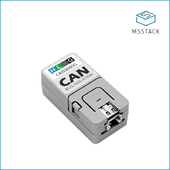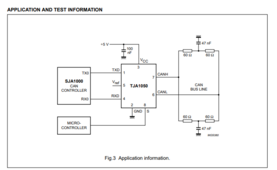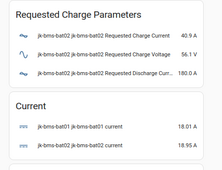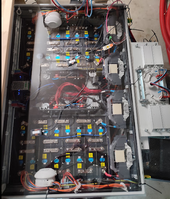silverstone
Solar Enthusiast
- Joined
- May 3, 2022
- Messages
- 1,041
Thanks ... The issue was the CAN adapter/hat, NOT the Atom S3 Lite itself.
Thanks ... The issue was the CAN adapter/hat, NOT the Atom S3 Lite itself.
Like I said, feel free to submit a pull request.Stupid me using the wrong pinout. But IMHO this should be included in the documentation @MrPablo.
Again, it's a valid pointLike I said, feel free to submit a pull request.
I don't think we can preemptively document pinouts for hardware that we're not using internally and that isn't tested by us.
It'll become a burdensome task rather quickly.
Regarding the inverter CANH/L side, there is only one physical swap possibility at the ESP32 sideThe way I see it,
it takes at most one trial and error swap to get the BMS-UART pins correct.
Whether the wires are physically swapped at the BMS side, or the s/w definition side. Anyone of the two, but never both at once.
The same goes for trial and error swap to get the UART-CAN pins.
Wires swap possibility is at the ESP to CAN transceiver UART side or again the s/w definition side. Anyone of the two, never both at once.
Regarding the inverter CANH/L side, there is only one physical swap possibility at the inverter side.
It's quite a nice unit, the Atom has sockets on the underneath that mate up with the pins on the adaptor. It essentially just plugs in.Again, it's a valid point.
But like I said, I didn't know where to buy the recommended adapter and didn't want to wait 1 month or so ...
Plus I cannot figure out how it would connect to the Atom S3 Lite in the first place.
Do you have some schematic / photos for that ?

Once you changed the details for the MQTT of the build firmware, you need o clean MQTT, in some cases you also need to remove the device under MQTT add-on and/or the last step (may not need but can be last resource) is to restart MQTT server.Something is very wrong.
I have 2 entities in MQTT and I disabled what I believe was the old one (which had some activity, but is the wrong/old ESP32 board, NOT the ESP32s3):
View attachment 204532
Item number 2 is disabled.
View attachment 204533
Now only 9 cell are being reported.
What is going on ?
Do I really need 2 MQTT devices for the same physical device ?
EDIT 1: Might be something temporary after i disabled item number 2. Re-enabled and Re-disabled item number 2. Now all 16 cells are back in frontend. Weird ...

Alright ... But the A103 SKU for that I cannot find anywhere. Maybe in stock by Mouser in 1 month ...It's quite a nice unit, the Atom has sockets on the underneath that mate up with the pins on the adaptor. It essentially just plugs in.
View attachment 204543
It is working correctly now. WITHOUT termination resistor even ...Once you changed the details for the MQTT of the build firmware, you need o clean MQTT, in some cases you also need to remove the device under MQTT add-on and/or the last step (may not need but can be last resource) is to restart MQTT server.
Regarding your Can bus problem. Please check to see the impedance of the entire wire! See the test case for the TJA1050. Can refer to this as well, page 21: https://www.nxp.com/docs/en/application-note/AN00020.pdf
View attachment 204547
Often when the run is short and there are no more than 2 nodes on the CANbus then you can get away without a termination resistor at both ends.It is working correctly now. WITHOUT termination resistor even ...

So should I just put it back ?Often when the run is short and there are no more than 2 nodes on the CANbus then you can get away without a termination resistor at both ends.
The spec calls for it though, and it will likely reduce errors.
If / when there's a multiBMS solution over CANbus, it will become more critical.
Interesting, that suggests that either the inverter is not respecting the CCL, or there's a calibration issue on your BMSs, but that would be a hell of a difference...There is a bit of a difference between requested / actual current though.
Keep in mind that I am ONLY controlling batter 02. Battery 01 will just get whatever the inverter deliver minus what is taken by battery 02.
120A requested , 140A delivered ... Uhm ...
View attachment 204549
And looking at the Charge control spreadsheet it should go up to 144 A which is much closer to the delivered value.
What do you mean "Interesting"Interesting, that suggests that either the inverter is not respecting the CCL, or there's a calibration issue on your BMSs, but that would be a hell of a difference...
As for the resistor, it's up to you.


in my case, the inverter mesures current is quiet inaccurate (+/-10-15A) + JK current mesurements are crap too (20A short sometimes)...only one point of truth is the victron shunt. So adding quiet a good amount of security buffer is recommendedI tuned the max charging current to 45A using the slider (i.e. 45A for both batteries) for a quick test.
Current dropped accordingly so it IS working. Not ultra precise, but good enough
View attachment 204553
EDIT: I also probably made the current control WAY too aggressive. But since OTA didn't work last time, I am not so sure about reflashing ...
That's also what I'm observing.in my case, the inverter mesures current is quiet inaccurate (+/-10-15A) + JK current mesurements are crap too (20A short sometimes)...only one point of truth is the victron shunt. So adding quiet a good amount of security buffer is recommended

I calibrated the voltage (at NO LOAD !), not the current though.From the JK faq's on the latest BMS
voltage inaccuracy
Measure the actual total voltage of the battery pack with a multimeter, and fill in the actual total voltage into the "Voltage Calibration" in the parameter setting page.
The current is not allowed
1, BMS B- and P- are two 7AWG wires, both need to be connected in parallel, otherwise it will lead to current error.
2、Use a clamp meter to measure the actual current of the battery pack, fill in the actual current into the parameter setting page "current calibration" inside; the larger the actual current, the higher the calibration accuracy.
So always assume your JK BMS is reading volts and amps incorrectly and recalibrate.


